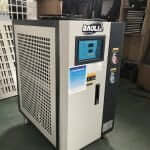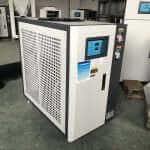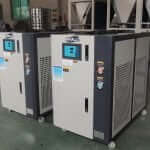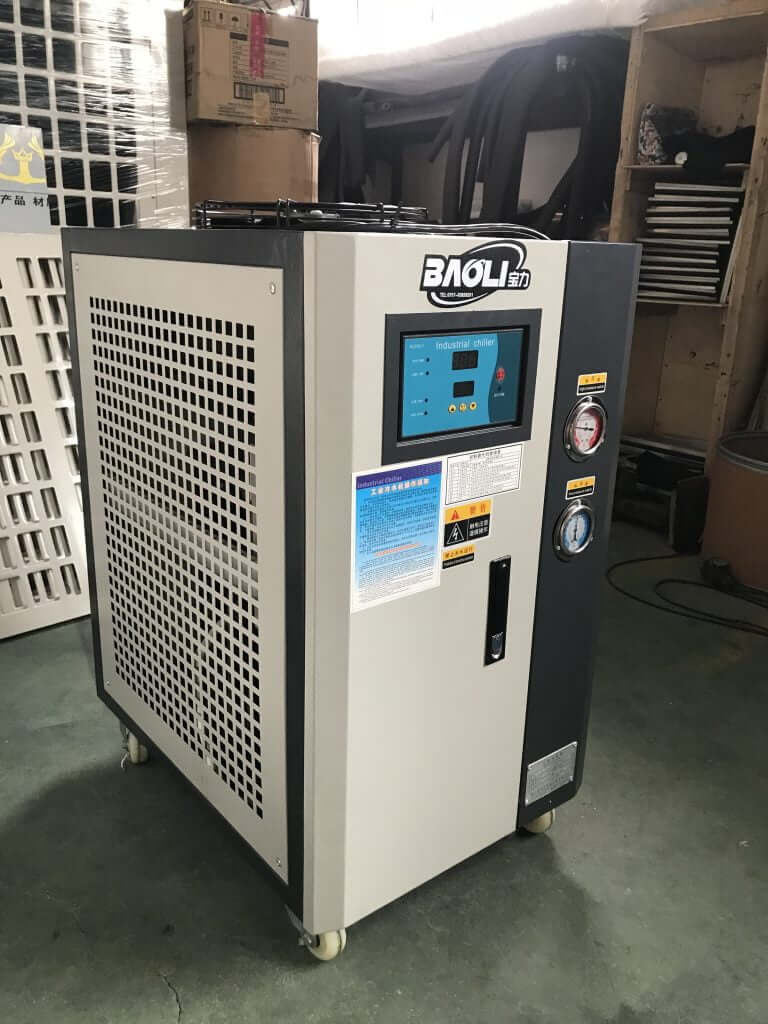Introduction:what is aquarium chiller?
Aquariums are not just a beautiful addition to our living spaces; they are miniature ecosystems that require careful maintenance to ensure the health and well-being of the aquatic life within. One of the crucial elements in maintaining a stable and suitable aquatic environment is the proper temperature control. This is where aquarium chillers come into play. An aquarium chiller is a device designed to lower the water temperature in the tank when it rises above the desired level, mimicking the natural conditions that many aquatic species need to thrive. Whether you have a saltwater reef tank with delicate corals and fish or a freshwater aquarium with temperature-sensitive species, choosing the right chiller is essential to prevent stress, disease, and even death among your aquatic inhabitants.
العوامل التي يجب مراعاتها عند الاختيار
يعد حجم حوض السمك الخاص بك عاملاً أساسيًا في تحديد سعة المبرد المناسبة. سيتطلب الخزان الأكبر حجمًا مبردًا أكثر قوة لتبريد الكمية الأكبر من الماء بشكل فعال. كقاعدة عامة، يجب عليك حساب حجم الخزان بالجالون أو اللتر. على سبيل المثال، صغير 20 – سيكون لخزان الجالون متطلبات تبريد مختلفة مقارنةً بـ 100 جالون – gallon tank. A chiller that is too small for the tank will struggle to maintain the desired temperature, leading to fluctuations that can be harmful to the fish and plants. On the other hand, a chiller that is too large will not only be a waste of money but may also cause excessive cooling, which can also have negative impacts. It’s important to find a chiller that is rated for the appropriate tank size to ensure efficient and accurate temperature control.
-
Water Temperature Requirements
الأنواع المائية المختلفة لها تفضيلات محددة لدرجات الحرارة. تزدهر بعض الأسماك والشعاب المرجانية في المياه الباردة، بينما يفضل البعض الآخر بيئة أكثر دفئًا قليلًا. على سبيل المثال، عادة ما تكون الأسماك الاستوائية جيدة في درجات حرارة تتراوح بين 75 درجة فهرنهايت و82 درجة فهرنهايت، في حين أن بعض اللافقاريات البحرية مثل بعض أنواع الشعاب المرجانية قد تتطلب نطاق درجة حرارة أكثر دقة حوالي 78 درجة فهرنهايت. من الضروري البحث عن احتياجات درجة الحرارة للكائنات الحية المحددة في حوض السمك الخاص بك. إذا كان لديك مجتمع متنوع من الحياة المائية، فقد تحتاج إلى إيجاد درجة حرارة مناسبة تناسب معظمهم. يجب أن يكون المبرد الذي تختاره قادرًا على الحفاظ على نطاق درجة الحرارة المطلوب بدقة. تأتي بعض المبردات المتقدمة مزودة بإعدادات درجة حرارة قابلة للبرمجة، مما يسمح لك بتخصيص درجة الحرارة وفقًا لاحتياجات سكان حوض السمك الخاص بك.
Energy efficiency is an important consideration when choosing an aquarium chiller. A more energy-efficient chiller will not only save you money on your electricity bills in the long run but is also more environmentally friendly. Look for chillers that have high energy efficiency ratings. These often use advanced technologies and components to minimize power consumption while still providing effective cooling. Some features to look for include efficient compressors, good insulation, and intelligent temperature control systems that adjust the cooling output based on the actual temperature needs. Investing in an energy-efficient chiller may initially cost a bit more, but the savings over time can be significant, especially for larger aquariums that require continuous cooling.
The noise level of the chiller can have a significant impact on both the aquatic life and the surrounding environment. A noisy chiller can cause stress to the fish, which may affect their behavior and health. In a home setting, a loud chiller can also be a nuisance to the occupants. When choosing a chiller, look for models that are designed to operate quietly. Some manufacturers use sound-dampening materials and advanced motor technologies to reduce noise. It’s a good idea to read reviews and ask for recommendations from other aquarium owners about the noise levels of different chillers. A quiet chiller will provide a more peaceful and relaxing environment for your aquarium and your home.
Choosing a reputable brand with reliable products is essential when it comes to aquarium chillers. A well-known brand is more likely to have a track record of producing high-quality, durable, and reliable equipment. Look for brands that have been in the market for a while and have positive customer reviews. Reliable chillers are less likely to break down or malfunction, which can be disastrous for your aquarium. They also often come with better warranties and customer support. Brands that invest in research and development are more likely to offer advanced features and better performance. Do your homework and research different brands to ensure you are investing in a chiller that will provide long-term reliable service for your aquarium.
إرشادات لاختيار مبرد حوض السمك
قبل إجراء عملية شراء، من المهم إجراء بحث شامل. ابحث عبر الإنترنت عن مراجعات المنتجات ومقارناتها وآراء الخبراء. تعد منتديات ومواقع الأحياء المائية المخصصة للهوايات المائية مصادر رائعة للمعلومات. اقرأ عن تجارب أصحاب أحواض السمك الآخرين الذين استخدموا مبردات مختلفة. يمكن أن يمنحك هذا نظرة ثاقبة حول الأداء والموثوقية وأي مشكلات محتملة للنماذج المختلفة. انتبه إلى التفاصيل مثل مدى احتفاظ المبرد بدرجة الحرارة، واستهلاكه للطاقة، ومستوى الضوضاء، وسهولة التركيب والصيانة. من خلال جمع أكبر قدر ممكن من المعلومات، يمكنك اتخاذ قرار أكثر استنارة وزيادة فرص اختيار المبرد الذي يلبي احتياجاتك الخاصة.
If you are new to aquarium keeping or unsure about which chiller is right for your setup, it can be beneficial to consult with aquarium experts or experienced hobbyists. They can provide valuable advice based on their knowledge and experience. Aquarium store employees who are knowledgeable about the products they sell can also offer guidance. They may be able to recommend specific models based on your tank size, the species in your aquarium, and your budget. Additionally, joining local aquarium clubs or online communities can give you access to a network of experienced individuals who can share their insights and experiences. Don’t be afraid to ask questions and seek advice from those who have more experience in maintaining a healthy aquatic environment.
في حين أنه من المهم اختيار مبرد عالي الجودة، إلا أنك تحتاج أيضًا إلى مراعاة ميزانيتك. تأتي مبردات أحواض السمك بمجموعة واسعة من الأسعار، اعتمادًا على ميزاتها وقدرتها وعلامتها التجارية. حدد الميزانية التي تناسبك، ولكن عليك أيضًا أن تدرك أن النماذج الأرخص ثمناً قد لا تقدم دائمًا أفضل أداء وموثوقية. إنها فكرة جيدة أن توازن بين التكلفة والجودة. ابحث عن مبرد يقدم قيمة جيدة مقابل المال في حدود ميزانيتك. ضع في اعتبارك التكاليف طويلة المدى أيضًا، بما في ذلك استهلاك الطاقة ونفقات الصيانة المحتملة. في بعض الأحيان، يمكن أن يؤدي الاستثمار مقدمًا في مبرد ذي جودة أفضل إلى توفير المال على المدى الطويل من خلال توفير تبريد أكثر كفاءة وتقليل الأعطال.
Think about the ease or complexity of installing and maintaining the chiller. Some chillers are designed for easy installation and come with clear instructions and all the necessary fittings. Others may require more technical knowledge and installation skills. Consider your own capabilities and whether you will need to hire a professional for installation. In terms of maintenance, look for chillers that are easy to clean and have accessible components for servicing. Regular maintenance is essential to keep the chiller running efficiently and prolong its lifespan. Check if the manufacturer provides maintenance guidelines and whether replacement parts are readily available. A chiller that is easy to install and maintain will save you time and effort in the long run and ensure that it continues to perform well.
خطوات محددة لاختيار مبرد حوض السمك المناسب
-
تحديد متطلبات حوض السمك الخاص بك
– قياس حجم الخزان: قم بقياس طول وعرض وارتفاع حوض السمك الخاص بك بدقة لحساب حجمه بالجالون أو اللترات. ستكون هذه هي نقطة البداية للعثور على مبرد بالسعة المناسبة.
– بحث الأنواع’ احتياجات درجة الحرارة: حدد أنواع الأسماك والنباتات والكائنات الحية الأخرى الموجودة في حوض السمك الخاص بك وابحث عن نطاقات درجات الحرارة المثالية لها. ابحث عن نطاق درجة حرارة مشترك يمكن أن يستوعب معظم السكان إذا كان لديك مجتمع متنوع.
-
حدد الميزانية
– Decide how much you are willing to spend on the chiller. Consider not only the initial purchase price but also the long-term costs such as energy consumption and potential maintenance. Remember that a higher-quality chiller may cost more upfront but could save you money in the long run.
-
Research and Shortlist
– Online research: Look for aquarium chiller reviews on reliable websites, forums, and social media groups dedicated to aquariums. Read about the performance, reliability, and user experiences with different models.
– Ask for recommendations: Talk to aquarium store employees, experts, and other hobbyists. They can provide insights based on their own experiences and knowledge.
– Create a shortlist: Based on your research and recommendations, shortlist a few chiller models that seem to meet your requirements in terms of capacity, temperature control, energy efficiency, and noise level.
-
Check Energy Efficiency Ratings
– Look for energy star ratings or other indicators of energy efficiency. Compare the power consumption of the shortlisted chillers to find the most energy-efficient option that fits your budget.
-
Evaluate Noise Levels
– Read reviews and ask about the noise levels of the shortlisted chillers. If possible, try to find videos or demonstrations that show how quiet or noisy a particular model is. Opt for a chiller that operates quietly to avoid stressing your aquatic life and disturbing your living environment.
-
Consider Brand and Reliability
– Research the brands of the shortlisted chillers. Look for brands with a good reputation for producing reliable and durable aquarium equipment. Check customer reviews for feedback on the brand’s after-sales service and warranty policies.
-
Examine Installation and Maintenance Requirements
– Read the product manuals or online descriptions to understand the installation process. Consider whether you have the necessary skills and tools for installation or if you may need to hire a professional.
– Look for chillers that are easy to maintain, with accessible filters, coils, and other components that may need cleaning or servicing. Check if the manufacturer provides clear maintenance guidelines and if replacement parts are readily available.
-
Make the Final Decision
– Compare all the factors for each shortlisted chiller. Consider which one offers the best balance of performance, reliability, energy efficiency, noise level, and ease of installation and maintenance within your budget. Make the final decision based on your comprehensive evaluation and purchase the chosen aquarium chiller.
Installation Considerations for Aquarium Chiller
- Space Requirements: Ensure that you have enough space around the aquarium to install the chiller. It should be placed in a location where it has proper ventilation and is not cramped. A chiller needs to dissipate heat, so it should not be placed in an enclosed area with limited air flow.
- Proximity to the Tank: The chiller should be located as close as possible to the aquarium to minimize the length of the tubing required for water circulation. Longer tubing can lead to increased pressure drops and potentially affect the chiller’s efficiency. However, make sure there is enough clearance around the chiller for maintenance and access.
- Avoid Direct Sunlight and Heat Sources: Do not install the chiller in a place where it will be exposed to direct sunlight or near heat sources such as radiators, heaters, or appliances that generate a lot of heat. This can cause the chiller to work harder than necessary to cool the water and may even lead to overheating of the chiller itself.
- حجم الأنبوب الصحيح: استخدم حجم الأنبوب الموصى به من قبل الشركة المصنعة للمبرد. يمكن أن يؤثر قطر الأنبوب غير الصحيح على معدل تدفق المياه وضغطها، مما قد يؤثر بدوره على أداء المبرد. تأكد من أن الأنابيب ذات نوعية جيدة وخالية من أي عيوب أو مكامن الخلل.
- التوصيلات الآمنة: يجب إجراء جميع توصيلات الأنابيب بشكل آمن لمنع التسربات. استخدم التركيبات والمشابك المناسبة لضمان إحكام الغلق. لا يمكن أن تتسبب التسريبات في إهدار المياه فحسب، بل قد تؤدي أيضًا إلى حدوث فوضى وربما تؤدي إلى تلف الأرضيات أو الأثاث المحيط. تحقق من عدم وجود تسربات بعد التثبيت عن طريق تشغيل المبرد لفترة قصيرة ومراقبة التوصيلات.
- Water Flow Direction: Follow the correct water flow direction as indicated in the chiller’s installation manual. Incorrect flow direction can lead to inefficient cooling or even damage the chiller’s internal components. Some chillers may have specific requirements for the inlet and outlet of water, so make sure to connect them correctly.
- Voltage and Amperage Requirements: Check the electrical requirements of the chiller and make sure that the power supply in your area can meet those requirements. Using the wrong voltage or insufficient amperage can cause the chiller to malfunction or not operate properly. It may also damage the electrical components of the chiller and pose a safety hazard.
- Grounding: Ensure that the chiller is properly grounded to prevent electrical shocks. Most electrical appliances come with a grounding wire or a grounding plug. Make sure to connect it to a properly grounded electrical outlet. If in doubt, consult an electrician to check the grounding of your electrical system.
- Power Cord Length and Placement: The power cord should be long enough to reach the electrical outlet without being stretched or strained. Avoid running the power cord across high-traffic areas or in a way that it can be easily damaged. If possible, use a cord cover or conduit to protect the power cord and make it look more organized.
-
Initial Startup and Testing
- Read the Manual: Before starting the chiller for the first time, carefully read the manufacturer’s instructions regarding the initial startup procedure. This may include steps such as filling the chiller with water (if required), priming the pump, and setting the initial temperature settings.
- Monitor Temperature: After starting the chiller, closely monitor the water temperature in the aquarium. Check if the chiller is able to reach and maintain the desired temperature within a reasonable time. If the temperature does not seem to be changing as expected or if there are any unusual fluctuations, turn off the chiller and check for any installation errors or problems.
- Check for Noise and Vibrations: Listen for any abnormal noise or vibrations coming from the chiller during operation. Excessive noise or vibrations may indicate a problem with the installation, such as improper leveling or a loose component. If you notice any issues, turn off the chiller and investigate further to ensure proper operation and longevity of the device.
خاتمة
يعد اختيار مبرد حوض السمك المناسب قرارًا حاسمًا يمكن أن يكون له تأثير كبير على صحة ورفاهية حيواناتك الأليفة المائية. من خلال النظر في عوامل مثل حجم الخزان وسعته، ومتطلبات درجة حرارة الماء، وكفاءة الطاقة، ومستوى الضوضاء، والعلامة التجارية والموثوقية، واتباع الخطوات المحددة للاختيار والتركيب، يمكنك اتخاذ قرار مستنير. سيساعد المبرد الذي تم اختياره جيدًا وتركيبه بشكل صحيح في الحفاظ على بيئة مائية مستقرة ومناسبة، مما يسمح للأسماك والنباتات والكائنات الحية الأخرى بالازدهار. تذكر أن استثمار الوقت والجهد في اختيار وتركيب المبرد المناسب هو استثمار في النجاح طويل المدى لحوض السمك الخاص بك والمتعة التي تحصل عليها من مراقبة أصدقائك المائيين ورعايتهم. لذا، خذ وقتك وقم بأداء واجباتك وقم باختيار أفضل الخيارات لإعداد حوض السمك الفريد الخاص بك.
To learn more about how chillers work and If you’re interested in our chiller, request a quote,
pls sent your E-mail to info@topwaterchiller.com, or call +(86) 139 2883 9015 .



















